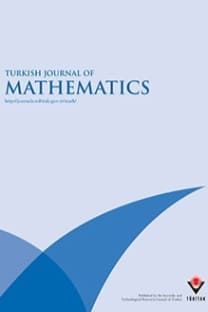An algorithm to check the equality of total domination number and double of domination number in graphs
An algorithm to check the equality of total domination number and double of domination number in graphs
___
- [1] Bahadır S, Gözüpek D. On a class of graphs with large total domination number. Discrete Mathematics & Theoretical Computer Science 2018; 20 (1): 23. doi: 10.23638/DMTCS-20-1-23
- [2] Bollobás B, Cockayne EJ. (1979). Graph-theoretic parameters concerning domination, independence, and irredundance. Journal of Graph Theory 1979; 3: 241-249.
- [3] Cyman J, Dettlaff M, Henning MA, Lemańska M, Raczek J. Total domination versus domination in cubic graphs. Graphs and Combinatorics 2018; 34 (1): 261-276.
- [4] Garey MR, Johnson DS. Computers and Intractability: A Guide to the Theory of NP-Completeness. New York, NY, USA: W. H. Freeman & Company, 1979, pp. 641-650.
- [5] Henning MA. (2001). Trees with large total domination number. Utilitas Mathematica 2001; 60: 99-106.
- [6] Hou X, Lu Y, Xu X. A characterization of (γt, 2γ)-block graphs. Utilitas Mathematica 2010; 82: 155-159.
- [7] Pfaff J, Laskar R, Hedetniemi S. NP-completeness of total and connected domination and irredundance for bipartite graphs. Technical Report 428. Clemson, SC, USA: Clemson University, 1983.
- ISSN: 1300-0098
- Yayın Aralığı: 6
- Yayıncı: TÜBİTAK
Characterizations of dual curves and dual focal curves in dual Lorentzian space D3 1
Sareh MEHDIZADEH GILANI, Yusuf YAYLI, Nemat ABAZARI
Dynamics of a fluid equation with Neumann boundary conditions
Limin CHEN, Yumei ZOU, Shengjun LI
The Meyer function on the handlebody group
Some higher-order identities for generalized bi-periodic Horadam sequences
Linear mappings satisfying some recursive sequences
Mehdi MOHAMMADZADEH KARIZAKI, Amin HOSSEINI
Some results on top generalized local cohomology modules with respect to a system of ideals
Vacuum isolating and blow-up analysis for edge hyperbolic system on edge Sobolev spaces
Nematollah KADKHODA, Morteza KOOZEHGAR KALLEJI
Classification of some subclasses of 6−dimensional nilpotent Leibniz algebras
Extension of Montgomery identity via Taylor polynomial on time scales
Khuram Ali KHAN, Khalid Mahmood AWAN, Ammara NOSHEEN, Sumaiya MALIK
